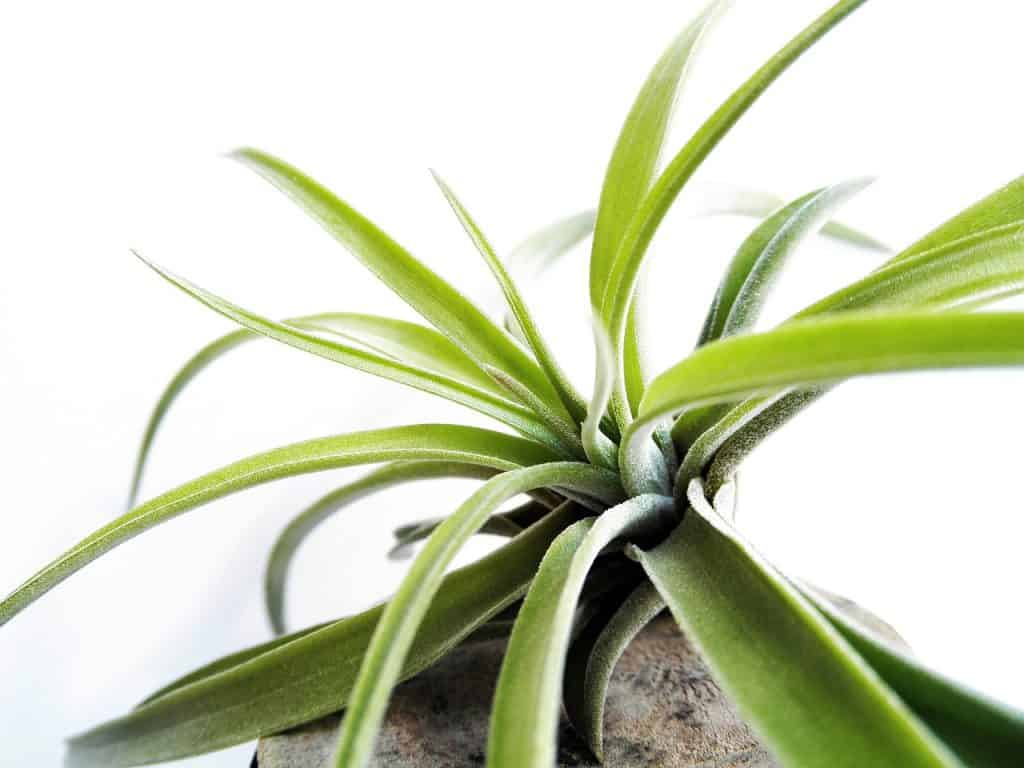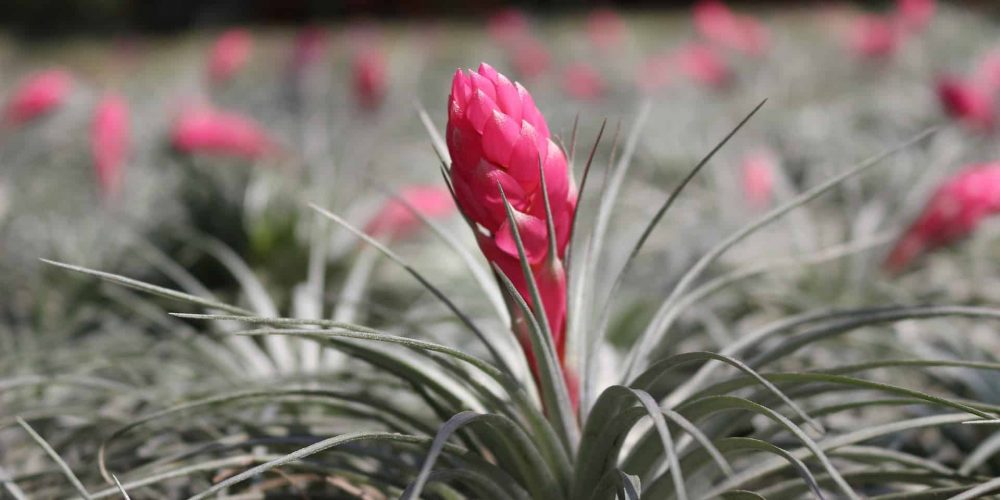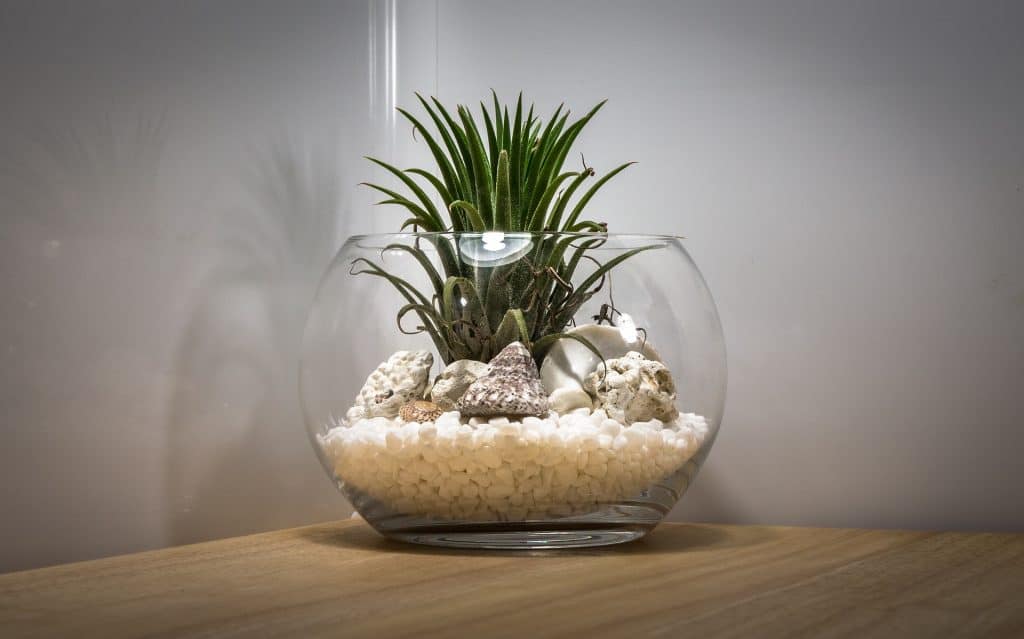
Air plants are unlike no other, they add an element of cuteness to any room. They are one of the easiest houseplants to manage, with the right knowledge. In this article, you’ll find everything you need to know how to take good care of air plants.
Quick air plant care summary: This easy to care for plant can survive in a wide temperature range of 7-35°C (45-95°F). They need bright but filtered light around 12 hours per day. Air plants prefer humid environments but can survive in drier places with good care. Most epiphytes are non-toxic but it’s always advisable to keep it away from pets and children anyway. To achieve optimal growth they will require fertilization two times per month.
Table of Contents
What Is An Air Plant?
An air plant, also known as epiphytes, are just plants that grow on top of other plants, in a symbiotic fashion. But to be more specific, it’s a type of symbitoic relationship known as commensalism. They co-exist in a harmless fashion.
These plants grow without soil, which has led to them adapting in various ways. These adaptations have allowed them to be successful at growing in nutrient deprived environments. There is one thing that you will find similar with all types of air plants. Their lust for humidity, it’s one of their main sources of nutrients. This is achieved through one of their many adaptations of course, but we’ll explore that later.
Origin of Air Plants
The name, epiphyte, is a direct translation from Greek meaning on top of plant. However, these plants have found themselves being native to many areas of the world. From South-Eastern areas of the USA, across the Caribbean and even in Argentina. Residing in many environments such as forests, mountains and even deserts. This alone shows you that you should have little problems keeping one in your home.
Types of Air Plants
There’s plenty of different types of air plants. So rather than go through them all, we’ve picked out some of our favourites and added some pictures of them:



Previous
Next
Sky Plant – Tillandsia Ionantha
The sky plant is known as a bromeliad plant, meaning that it grows in tropical climates and usually has a short stem. Towards the end of their life, they are known to bloom bright flowers.
Cotton Candy – Tillandsia Ionantha
This one’s actually a combination of two plants, making it a hybrid. But the name gives you a hint at what it looks like. It forms beautiful, pink, “cotton candy” flowers.
Spanish Moss – Tillandsia Usneoides
Spanish moss stands out from most air plants. Why? The leaves on it hang down rather than grow straight up. Usually they’re found draped over tree branches.
Ideal Locations In Your Home For Air Plants
To be honest, you can probably stick an air plant anywhere in your home and it would survive. But that’s not to say it wouldn’t require a bit of extra care in those areas. Ideally though, you’d want it in your bathroom.
This is down to them getting most of their nutrients out the air. So they need a humid environment but that’s not to say it can’t survive elsewhere. Regular misting or soaking it in water for a few hours are options if the air is dry.
In the right environment, you could see much more significant growth. So how fast do Air plants grow?Air plants are really slow growing. For the first year of their life, they typically stay under 1 inch in size. But don’t let that discourage you, after a few years they will start to grow a little quicker. Once they’ve matured, you will begin to see them flower, make pups, then die off. The pups will then grow into full flowers.

Watering Your Air Plants
As they don’t live in soil, watering your air plant is a little different to the typical methods. You will need to vary what you do depending on the environment.
For dry environments, you’ll have to soak your air plants in room temperature water 2-3 times per week. Always allow them to dry out slowly for about 3 hours. This prevents them being too wet, which can bring on diseases or pests.
Another option is to mist it regularly throughout the day, but this most likely will not suffice. Unless it’s in a humid environment such as your bathroom.
However, when soaking/misting your air plant you have to be mindful of the type of water. These plants can be sensitive to the wrong types of water. One common mistake people make is using distilled water, this should never be used. You need to be using filtered water or bottled water.
Humidity For Your Air Plants
These plants get the majority of their nutrients from the air and debris. So they do best in humid environments, this gives the plant an abundance of moisture for them to feast on. If you live in south-western Florida or a similar environment, you may be able to grow it outside.
Furry Plants
If you happen to notice that strange fur that covers your plant, it’s tiny hairs! Scientifically known as trichomes, are fine outgrowths on the surface of plants. But the trichomes on these plants are not just cute, they’re there for a purpose. They help the plant absorb water and nutrients.
Temperature For Your Air Plants
Whilst they can cope in a wide temperature range from 7-35°C (45-95°F). They will not do well outside of that, with the plant quickly dying. You can usually the notice the temperature is low as the plant may begin to look “weaker”. Common signs are browning leaves or shrivelled leaves.
Fertilizing Your Air Plants
If you’re wanting to achieve optimal health for your plant, then fertilizing it correctly is essential. You want to busing a good quality bromeliad fertilizer such as this one on amazon. Depending on which you go for, will vary how often it needs to be done.
There is some that can be applied daily as they hold lower concentrations of nutrients. But then there’s others that only need to be applied twice per month. So it depends on how much time you are willing to give to fertilizing.
Toxicity
Air plants are not toxic to cats and dogs. But it’s always best to keep them out of reach of pets and children. These plants are usually quite small so might be a tempting snack for some pets. Or even some small children!
Propagation
Air plants are super easy to propagate. It’s simply done by removing the pups and taking care of them as you did the mother. Follow our steps below and you’ll have new air plants growing in no time.
Removing Air Plant Pups
Before removing any pups, they need to be at least around 1/3 the size of the mother plant. To be safe, it’s better to wait until they’re around 1/2 the size of the host.
If they are at that size, then it’s pretty simple to get them off. You simply need to gently twist them away with a downward motion.
Mounting Your Air Plant Pups
Once you’ve got the pups off their mother, they can be mounted almost anywhere. Just ensure that you are able to sufficiently water it and ensure it gets plenty of light. You can mount by using any sort of glue, but make sure it’s waterproof. Fishing line is another alternative.
Air Plant / Epiphyte F.A.Q’s
Being such an interesting plant, brings many interesting questions. Check out some of our most commonly asked questions. If we haven’t answered yours, let us know what it is in the comments below!
How Do Epiphytes Reproduce?
Epiphytes reproduce in various ways. Some through vegetative action or seeds. Mainly they reproduce via “pups”. The plant will grow its own offspring, which can be planted elsewhere when they have reached an appropriate size.
Do Epiphytes Harm Trees?
No. Epiphytes exist in a commensalism fashion with their host. This is a type of symbiotic relationship. This essentially means that they co-exist in a harmless way.
Can Air Plants Live IN Water?
Whilst air plants do need water to live, they can’t live in water. This can bring many problems such as root rot. Dampness is the main weakness of an air plant. So it is definitely possible to overwater them. They should be kept out of water apart from when you are watering them.
How Long Do Air Plants Live?
Air plants are on the lower end in terms of lifespan. The plant itself usually lasts from a few months to around 2 years. But each life cycle will produce multiple offspring, so you can grow more each year. Meaning that if you only have 1 now, you could have 100s in a few years time.

GanceAsd
Monday 14th of June 2021
buy 5mg cialis online 800 mg black cialis over night ship 800 mg cialis online
coellAni
Sunday 13th of June 2021
texas rx pharmacy best rx pharmacy software real viagra online canadian pharmacy
coellGtv
Sunday 13th of June 2021
rx pharmacy glendale online mail order pharmacy cigna online pharmacy
coellHtf
Saturday 12th of June 2021
cialis 10 average dose of cialis cialis available in walgreens over counter??
HeleSwa
Thursday 10th of June 2021
brand levitra cialis viagra add to cart cialis at canadian pharmacy best way to take cialis